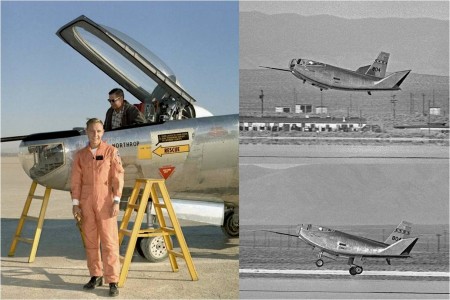
Forty-six years ago this month, the Northrop HL-10 lifting body made its first unpowered free flight. Following drop from NASA’s venerable NB-52B launch aircraft, test pilot Bruce A. Peterson successfully landed the HL-10 on Rogers Dry Lake at Edwards Air Force Base, California.
A lifting body is a wingless, aircraft-like vehicle which generates aerodynamic lift via the shape and size of its fuselage. The principal application for such a craft is in the realm of hypersonic lifting entry. The attributes of greatest interest here include the type’s favorable lift-to-drag characteristics and effective handling of the entry aerodynamic heating environment.
A true lifting body must operate at Mach numbers that range from hypersonic to subsonic. Flight controls are both aerodynamic and propulsive in nature. The former includes body flaps for pitch and roll control as well as rudders for yaw control. Propulsive thrusters are strategically arranged on the vehicle to augment control about all 3-axes at high altitude where dynamic pressure is low to negligible.
A lifting body’s unconventional shape makes the stability and control design task particularly challenging. The craft must fly at high angles-of-attack and large bank angles during hypersonic flight for trajectory ranging and aero heating accommodation purposes. Lifting bodies can also exhibit nasty lateral-directional handling qualities in the low-speed regime associated with landing.
Lifting bodies first came onto the aerospace scene in the 1960’s. An unmanned vehicle known as PRIME (Precision Recovery Including Maneuvering Entry) successfully flew a trio of suborbital flight tests between December 1966 and April 1967. High speed vehicle flight control was found to be entirely satisfactory.
A total of six (6) manned lifting body vehicles were tested at Edwards Air Force Base between 1963 and 1975. The subject aircraft included the NASA M2-F1, Northrop M2-F2, Northrop M2-F3, Martin X-24A, Martin X-24B and the Northrop HL-10. The primary purpose of this family of research vehicles was to investigate the transonic and subsonic flight characteristics of piloted lifting body aircraft.
The Northrop HL-10 measured 22.17 feet in length, 11.5 feet in height and 15.58 feet in width. The vehicle was configured with an XLR-11 rocket motor capable of generating 6,000 lbs of sea level thrust. GTOW for the single place vehicle was 9,000 lbs. NASA’s lengendary NB-52B mothership served as the launch aircraft. Drop typically took place at 450 mph and 45,000 feet.
The one and only HL-10 lifting body (S/N 804) made its inaugural free flight on Friday, 22 December 1967. NASA test pilot Bruce A. Peterson was at the controls of the tubby little ship. Since this flight was unpowered, the HL-10 was on the ground just 187 seconds after drop. The HL-10 handled well during the brief test flight and Peterson greased the landing.
The HL-10 flight test program was highly productive. Much was learned in the way of lifting body vehicle stability, control, and handling qualities. The HL-10 holds the distinction of flying higher (90,279 feet) and faster (1,227.5 mph; Mach 1.86) than any lifting body in aviation history.
The HL-10 completed a total of 37 missions (26 powered), the last of which occurred on Friday, 17 July 1970. In addition to Bruce Peterson (who, interestingly, flew only the first flight test), the aircraft was flown by John A. Manke (10 flights), William H. Dana (9 flights), Jerauld R. Gentry (9 flights) and Peter C. Hoag (8 flights).
Happily, the HL-10 airframe survived its flight test program intact. In tribute to its many aeronautical contributions, the aircraft has been preserved for posterity at Edwards Air Force Base. It is currently on public display, mounted on a pole, just outside the gate of the NASA Dryden Flight Research Center (DFRC).
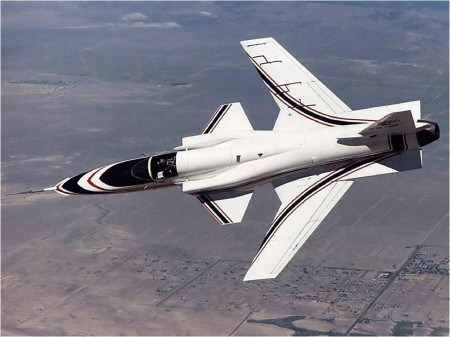
Twenty-eight years ago this month, the first DARPA/Grumman X-29A Forward Swept Wing experimental aircraft took to the air. The flight originated from Edwards Air Force Base with Grumman Chief Test Pilot Chuck Sewell at the controls.
The X-29A was designed to flight test the forward-swept wing (FSW) concept as applied to a fighter-type aircraft. The theoretical merits of this concept include greater agility, slower stall speeds, higher spin resistance, and better low-speed flight control relative to an aft-swept wing (ASW).
A key attribute of the FSW is that spanwise flow is directed from the wing tip toward the wing root. The result is that the wing root stalls before the wing tip at high angle-of-attack. This is advantageous in that a root stall is a more controllable flow condition than is a tip stall.
Due to the FSW’s inward spanwise flow, the outboard-located ailerons retain full control effectiveness since they remain in high energy air. Additionally, wing tip vortex strength is reduced and the associated drag-to-lift decreased. This results in better fuel economy and increased range performance.
Of course, these and other FSW benefits come at a price. The primary issue is related to wing structural dynamic characteristics. Due to the elastic nature of the wing structure, lift on a FSW tends to bend the wing tips upward. This deflection causes an increase in wing tip lift, which causes further bending. This problem becomes more severe with increasing aircraft speed.
The divergent structural response noted above will eventually cause the wing to structurally fail unless it is built strong enough to resist bending. Prior to the X-29A, the only solution to the FSW aeroelastic problem was to build a structually-strong, but very heavy wing. The X-29A would solve this problem through the medium of high-strength, lightweight composite wing construction.
The X-29A used an aeroelastically-tailored wing to provide the structural strength and stiffness required to effectively and safely employ its FSW. Carbon composite material was utilized to provide this weight-efficient solution to the age-old FSW structural divergence problem. The desired aeroelastic tailoring was achieved through judicious orientation of the constituent layers of carbon fiber.
In addition to aeroelastic tailoring of its wings, the X-29A also incorporated a number of other technologies to optimize its overall performance. These technologies included the use of relaxed static stability, a digital fly-by-wire flight control system, a thin supercritical airfoil section, three-surface pitch control, discrete variable-camber wing flaperons and full-authority close-coupled canards.
A pair of X-29A airframes ( S/N 82-0003 and 82-0004) were built by Grumman. These aircraft were converted from two existing Northrop F-5A Freedom Fighters. Control surface actuators and main landing gear came from the General Dynamics F-16 Fighting Falcon. The X-29A aircraft had a GTOW of 17,800 lbs. Power was supplied by a single General Electric F404 turbofan rated at 16,000 lbs of sea level thrust.
X-29A Ship No. 1 (S/N 82-0003) made its first flight on Friday, 14 December 1984 with Grumman Chief Test Pilot doing the honors. This flight took place at Edwards Air Force Base, California and was entirely satisfactory. Ship No. 1 would go on to make 254 flights before its retirement in 1990. Its stablemate (Ship No. 2, S/N 82-0049) first flew in May of 1989, flew 120 times and was retired in September 1991.
The X-29A Program was highly successful and thoroughly proved the technologies that made the FSW concept viable. Happily, both X-29A aircraft survived the type’s flight test program. Today, Ship No. 1 (S/N 82-0003) can be seen at the USAF National Museum in Dayton, OH. Ship No. 2 (S/N 82-0049) is displayed in front of the Dryden Flight Research Center located at Edwards Air Force Base, California.
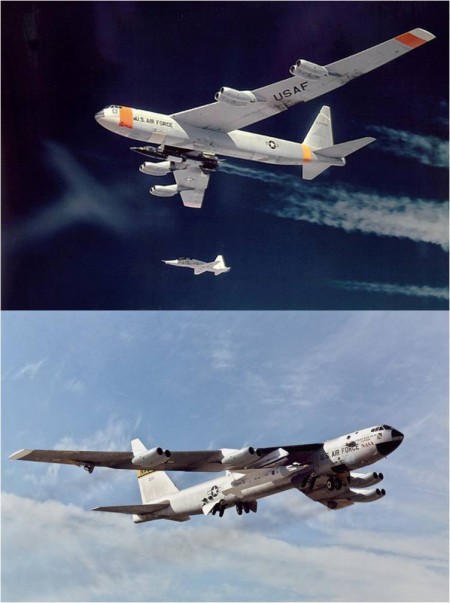
Eight years ago today, NASA’s storied NB-52B Stratofortress launch aircraft was retired following 44 years of service to the American flight research community. Although it was on flying status for nearly 50 years, the aircraft accumulated a total of only 2,443.8 flight hours.
The aircraft that became the NASA NB-52B (S/N 56-0008) started life as an RB-52B when it rolled off of the Boeing assembly line in 1955. First flight occurred on Saturday, 11 June 1955. USAF employed the aircraft as a testbed for B-52 bomb navigation systems.
In June of 1959, the aircraft joined the X-15 Program as a launch aircraft for North American’s famous manned hypersonic flight research rocket plane. Now designated as NB-52B, the eight-engine behemoth had previously been modified for the “mothership” role. The aircraft ultimately acquired the moniker “Balls 8” in deference to the last 4 digits in its USAF serial number.
Based at Edwards Air Force Base in California, the NB-52B made its X-15 Program debut on Saturday, 23 January 1960. On this day, Balls 8 launched X-15 Ship No. 1 (S/N 56-6670) with North American test pilot Scott Crossfield at the controls. It was the fifth flight test of the X-15 Program.
When the X-15 Program ended in late 1969, NASA’s NB-52B had served as the launch aircraft for roughly 140 of the X-15’s 199 research flights. But there would be many more chapters written in the hugh mothership’s story. Indeed, this story would continue to unfold over the next 35 years.
The list of flight test programs supported by Balls 8 is impressive by any measure. Among others, the NB-52B served as the launch aircraft for the legendary lifting body series (M2-F2, M2-F3, HL-10, X-24A and X-24B). Included in this list is the X-38 Crew Return Vehicle (CRV).
NASA’s NB-52B served as the first carrier aircraft for Orbital Science’s Pegasus air-launched, winged, multi-stage rocket. Balls 8 also supported the Space Shuttle Program by dropping solid rocket booster test vehicles to flight test the Shuttle booster’s parachute recovery system. The Space Shuttle Orbiter’s retro-fitted landing drogue parachute was also tested by Balls 8.
The last flight research project supported by NASA’s fabled NB-52B was the HYPER-X Program. This experimental effort involved flight testing an airframe-integrated scramjet engine on an X-aircraft known as the X-43A. Fittingly, Balls 8’s last flight test program would be like its first in that both involved hypersonic flight.
Balls 8 made its last flight on Tuesday, 16 November 2004. The mission was entirely successful as the X-43A scramjet operated at Mach 9.68 (6,598 mph at 110,000 feet). Balls 8 triumphantly returned to Edwards Air Force Base and performed one final flyover of the NASA Dryden Flight Research Center. The aircraft actually made two landings as first the co-pilot and then the command pilot landed on the concrete.
Balls 8 was officially retired on Friday, 17 December 2004 in ceremonies jointly conducted by USAF and NASA. As part of the festivities, NASA returned the NB-52B to the Air Force since technically the aircraft had been on indefinite loan to NASA since the late 1950’s! Today, the aircraft is on public display outside just the north gate at Edwards Air Force Base.
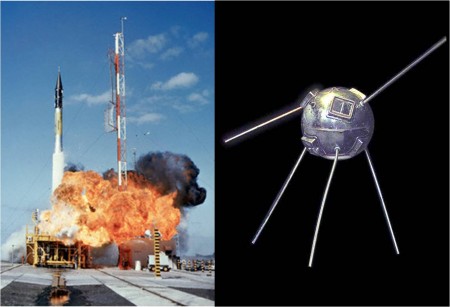
Fifty-five years ago this month, the United States attempted to launch the nation’s first satellite in response to the Soviet Union’s recent orbiting of Sputnik I. Unfortunately, the Vanguard TV-3 launch vehicle lost thrust moments after lift-off and exploded on the launch pad.
The International Geophysical Year (IGY) was a cooperative international scientific effort whose goal was to study the physical properties of the Earth. A total of sixty-seven (67) countries participated in the IGY which involved experimentation in eleven (11) physical science categories. The IGY lasted from 01 July 1957 to 31 December 1958.
Project Vanguard was established in 1955 by the United States for the purpose of orbiting the nation’s first satellite during the IGY. The Naval Research Laboratory (NRL) managed the project with the Martin Company, General Electric, Aerojet General and Grand Central Rocket Company as contractors.
Project Vanguard involved the development of both the launch vehicle and satellite payload. The Martin Company was the prime contractor for the Vanguard 3-stage launch vehicle while the NRL developed various Vanguard satellites. Launch took place from Cape Canaveral, Florida.
The Vanguard Satellite Launch Vehicle (SLV) was based on the design and technology of Martin’s single-stage Viking rocket. The SLV measured 75 feet in length and had a maximum diameter of 3.74 feet. Lift-off weight was 22,156 lbs. First, second and third stage average thrusts were rated at 30,303 lbs, 7,599 lbs and 2,599 lbs, respectively.
The original Vanguard satellite weighed a mere 3.25 lbs and included seven (7) mercury cell batteries, a pair of tracking radio transmitters, a temperature sensitive crystal, and six (6) solar cells mounted to its external surface. A total of six (6) data transmission and space tracking antennas protruded from the satellite’s spherical body as well.
On Friday, 04 October 1957, the Soviet Union orbited the world’s first artificial satellite, Sputnik I. Then, on Sunday, 03 November 1957, the Soviets orbited Sputnik II with the mongrel dog Laika onboard. These twin space feats both impressed the world and stunned the United States. As a result, success with Project Vanguard took on more significance and emphasis shifted to getting America into space pronto.
Vanguard Test Vehicle No. 3 (TV-3) was America’s first attempt to launch a Vanguard satellite into earth orbit. In truth, neither the Vanguard project nor Vanguard SLV was ready for the mission. However, the pressure to get America into space forced the project to expedite its carefully planned, but time-consuming flight test schedule. The results of doing so would not be good.
On Friday, 06 December 1957, Vanguard TV-3 lifted-off at 16:44:34 UTC from LC-18A at Cape Canaveral, Florida. Then, just 4 feet above the launch pad and 2 seconds into flight, the rocket’s first stage rocket motor lost thrust. TV-3 fell back onto the pad, rupturing its propellant tanks. The resulting massive explosion and fire totally consumed the vehicle and severely damaged the launch pad.
The TV-3 launch attempt was televised live to a worldwide audience numbering in the millions. Interestingly, the tiny Vanguard satellite somehow survived the post-crash inferno and was discovered intact at the edge of the launch complex apron. Though no longer flightworthy, the plucky satellite was dutifully beeping away as though it were in space.
The public response to the failed TV-3 mission was immediate and brutal. The ne’er-do-wells in the American press corps referred to the event with such delightfully derogatory terms as “Oopsnik”, “Kaputnik”, “Flopnik” and “Stayputnik”. However, the unkindest cut of all came from the mouth of Soviet Premier Nikita Khrushchev who mockingly described the diminutive Vanguard satellite as America’s little grapefruit.
The Vanguard Program would eventually see success. Indeed, the first Vanguard satellite (Vanguard 1) reached orbit on Monday, 17 March 1958. In fact, that satellite is still in space and is expected to remain there for at least two hundred more years. However, Vanguard 1 was Amerca’s second satellite to achieve orbit. The distinction of being first goes to the United States Army’s Explorer I satellite which was carried into orbit by a Jupiter-C launch vehicle on Friday, 31 January 1958.
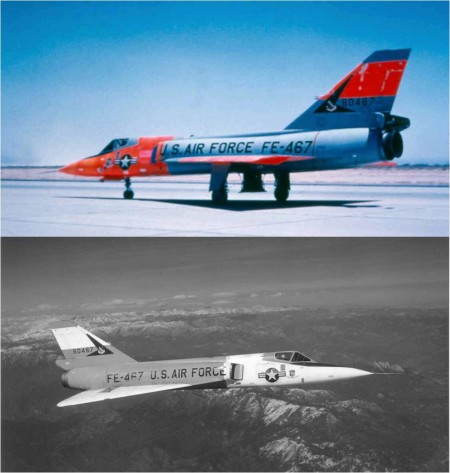
Fifty-three years ago this month, a USAF/Convair F-106A Delta Dart was clocked at 1,525.695 mph on an 11-mile straight course at Edwards Air Force Base, California. The mark still stands as an absolute speed record for single-engine turbojet-powered aircraft.
The USAF/Convair F-106 Delta Dart was designed for the all-weather interceptor role in defense of CONUS. As such, the Delta Dart’s primary mission was to seek out Soviet bomber formations and destroy same using its internally-carried missiles. Armament consisted of either (1) a quartet of Hughes AIM-4 Falcon missiles and a single AIM-26A Falcon missile or (2) a single Douglas AIR-2 Genie missile.
A member of the fabled Century Series, the Delta Dart was produced in two variants. The single place version was known as the F-106A while the dual place version was designated as the F-106B. Though primarily a trainer, this aircraft was also combat-capable. A total of 340 Delta Dart aircraft were manufactured by Convair; 277 F-106A’s and 63 F-106B’s.
The F-106A Delta Dart measured 70.7 feet in length and had a wing span of 38.25 feet. Gross Take-Off Weight (GTOW) and Empty Weight were 34,510 lbs and 24,420 lbs, respectively. Power was supplied by a single Pratt and Whitney J75-17 afterburning turbojet which produced 24,500 lbs of thrust at sea level.
The sleek Delta Dart was aerodynamically very clean. This was due in large measure to use of fuselage area ruling and a thin delta planform wing. The F-106A could climb at 29,000 feet per minute and had a service ceiling of 57,000 feet. Maximum unrefueled range was on the order of 2,700 nm.
Due to its impressive performance, USAF employed the F-106A in an attempt to regain the single-engine absolute speed record from the Soviets in late 1959. The existing record of 1,483.84 mph had been established in 1956 by a Soviet Ye-66 aircraft specially designed for setting the speed mark. The Air Force’s absolute speed record attempt was codenamed Project Firewall.
USAF originally selected F-106A (S/N 56-0459) to make the 1959 absolute speed record attempt. The aircraft was modified slightly to optimize its speed performance. However, 56-0459 experienced engine compressor stall problems and did not set the actual record. Rather, an unmodified F-106A (S/N 56-0467) was called into service and set the speed record reported here.
On Tuesday, 15 December 1959, USAF Major Joseph W. Rogers departed Edwards Air Force Base in a quest to establish a new absolute speed record for a single-engine turbojet-powered aircraft. Flying at 40,000 feet, Rogers and his F-106A averaged 1,525.695 mph over an 11-mile straight course to set a new speed mark.
For his remarkable airmanship on Project Firewall, Joe Rogers was presented with the Distinguished Flying Cross, the DeLavaulx Medal, and the Thompson Trophy. Rogers went on to a remarkable military career spanning 29 years. He retired in 1975 as a full colonel.
For its part, the Delta Dart went on to a 28-year operational life (1959-1987) with the United States Air Force and the Air National Guard. Considered by many to be the finest interceptor in aviation history, the Delta Dart is known to this day as the Ultimate Interceptor.





